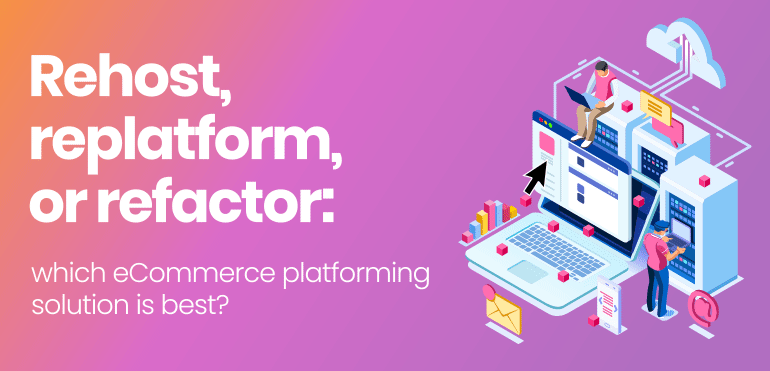Rehost, replatform, or refactor: which eCommerce platforming solution is best?

Article topics
To ensure your eCommerce store keeps customers happy, you must carry out regular maintenance, whether that’s removing dead links, reviewing page metadata, or optimising your images.
However at some point, you may decide to move your store to a new platform. The reasons behind this can vary:
- You want to go with a new hosting provider
- Your store has scaled to the point that your current platform can’t sustain it
- Your store is old, and you want to take advantage of something newer and faster
When you’re looking to migrate, there are three ways you can do this. You can rehost your site, replatform it, or refactor it. There are advantages and disadvantages to each, and we’ll look at them all in this article.

Rehost
Rehosting is often referred to as a ‘lift and shift.’ This is when you take your existing eCommerce store and move it to a new platform to improve efficiency and resilience.
Think of it like moving from one house to another. You keep the same furniture; you’re just moving to a new location!
The benefit of rehosting is that it’s easy and cost-effective to do. There are no significant development changes, and you can avoid disrupting your eCommerce customers.
However, as you’re moving your site across ‘as-is,’ you’re not taking advantage of all the benefits a new platform can provide. If your eCommerce site is old or has known issues, this can cause problems further down the line.

Refactor
Refactoring is when you either rebuild your website or modernise it completely to ensure you get all the benefits your new platform can offer. It’s sometimes referred to as ‘rearchitecting.’
Think of it like constructing a new house on a plot of land. While it might take time to create, you’re building it to your exact specifications.
An example of refactoring in action is when you move from a monolithic architecture to headless architecture. You’re restructuring and optimising your site substantially to bring long-term benefits to your store.
The great thing about refactoring is that you can optimise your site and build new functionality. This ensures your website runs faster and more efficiently in the future. However, this is generally the most expensive and time-consuming option available. Thorough testing is also needed to ensure everything works as it should.

Replatform
Replatforming is a compromise between rehosting and refactoring and is often referred to as ‘lift, tinker, and shift.’
While you’re moving your current eCommerce store to a new platform, you are making some changes to take advantage of all the benefits the new platform can provide.
Think of it like moving from one house to another, but you’re bringing some new furniture with you that better suits your brand-new pad!
The advantage of replatforming is that you’re making the changes that will provide you with the best return on investment in the long term. However, it’s crucial to spend time beforehand to identify which changes you want to make and ensure scope creep doesn’t occur. A poorly planned and managed replatforming project can cost you more time and money than you initially expected.
Replatforming your eCommerce site? Check out our ultimate guide to replatforming to ensure you don’t miss anything out!
Which eCommerce platforming solution should I choose?
All three platform solutions have their pros and cons.
If you need to move your site quickly, or are happy with the way it performs, it might be that a rehosting solution is enough for your needs. Alternatively, if you have the time to rebuild your website from scratch and ensure it’s futureproofed, you may want to do a refactoring.
Some businesses initially rehost their site and then arrange for more substantial changes to be made at a later date. This means they can move across quickly and improve the site at their convenience.
It’s essential to determine the reason why you’re moving to a new eCommerce platform and identify the goals you want to achieve from your migration. This will help you understand which migration strategy is right for your needs.
Don’t worry if you’re not sure which option is right for you.
We hope this article has explained what rehosting, replatforming, and refactoring are, and which is the best choice for your eCommerce store.
Still not sure what the difference is? Don’t panic! A skilled eCommerce agency (like Xigen) will audit your existing store, recommend which option to go for, and ensure your migration runs smoothly without disruptions.
Our team of eCommerce experts are here to help if you’re looking to improve the online experience for your customers. Contact us today to find out more.


 Back
Back
